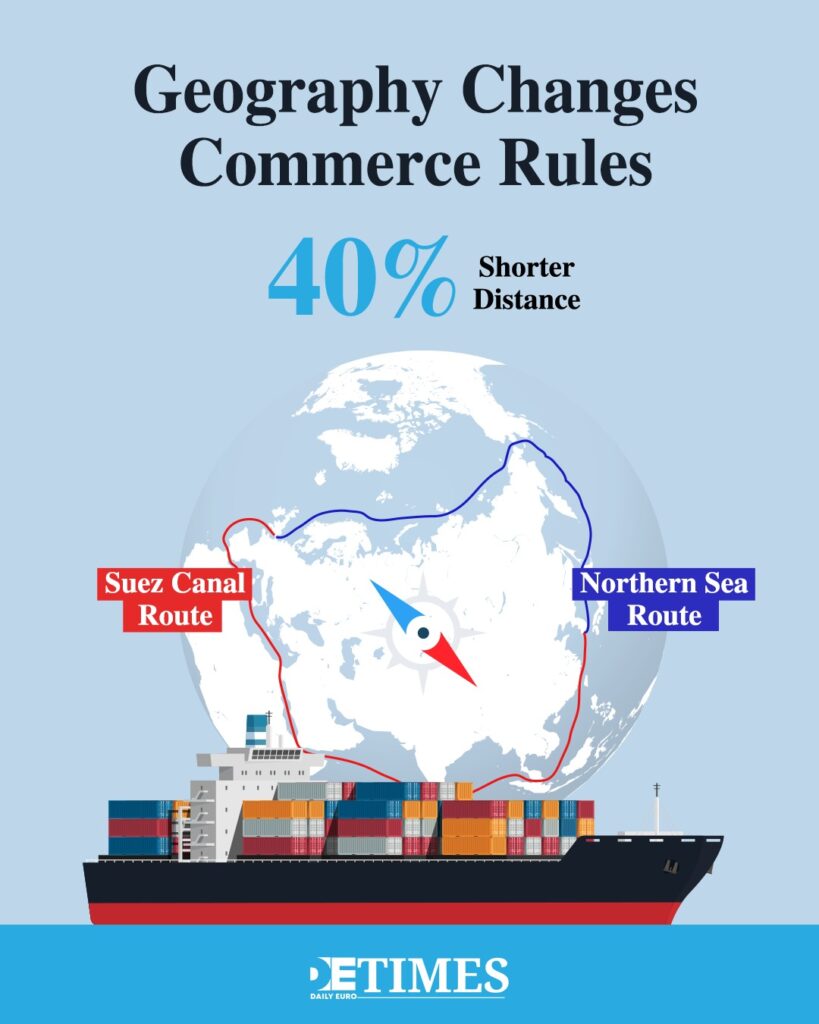The Istanbul Bridge container ship finished loading at Ningbo-Zhoushan port on 24 September, heading for Britain’s Felixstowe through Russia’s icy northern waters in the Arctic.
This trip kicked off the world’s first commercial China-Europe Arctic Express service.
The 18-day journey cuts shipping time in half compared to the old Suez Canal route. Where regular shipping takes 30-50 days via Cape of Good Hope or Suez, the Arctic passage gets cargo to European ports in under three weeks.
Geography Changes Commerce Rules
Russia runs the Northern Sea Route through its waters along thousands of kilometres of Arctic coastline. The numbers work out well for the polar route.
Ships going from Northwest Europe to the Far East find the Northern Sea Route roughly 40% shorter compared to the Suez Canal route. This shorter distance means 30-40% less sailing time while cutting fuel use and emissions big time.
Climate change opened this door for good. Global warming makes the northern passage workable without hitting sea ice zones for longer stretches each year.
Economics Over Politics
Chinese shipping companies are hunting for Arctic alternatives to skip traditional bottlenecks and cut transit times to Europe. Red Sea problems from regional fights make backup routes look better money-wise.
The Arctic route takes half the time of going through the Suez Canal. For container shipping operations, this time cut delivers quick cost benefits through less fuel burning and faster inventory turnover.
Russia makes money from transit fees and gets political leverage. The Northern Sea Route gives Moscow cash flow separate from old European energy deals. China gets supply chain backup while cutting dependence on shaky Middle Eastern passages.

Europe Sits On Sidelines
European shipping companies stay cautious about Arctic business. No big European carrier has jumped into regular Arctic container services despite the obvious time benefits.
This careful approach hurts European logistics competitiveness directly.
While Chinese and Russian companies build Arctic shipping know-how and infrastructure, European firms keep using old routes that take twice as long to finish.
European manufacturers buying Asian parts deal with longer supply chains while competitors get faster Arctic options. This disadvantage adds up over millions of containers yearly, hitting everything from car parts to electronics.
Business Beats Politics
Ships running via the Northern Sea Route can slow down by 40% and still show up at the same time as vessels racing at full speed through Suez. This efficiency turns into lower shipping costs and less environmental damage.
The Arctic route helps European consumers despite political fights over Ukraine. British ports like Felixstowe take Chinese cargo no matter how it gets there through Russian waters.
Business needs beat diplomatic games when consumers want cheap goods delivered fast.
Russia gets what it wanted since Soviet times: a working northern trade corridor separate from old bottlenecks.
China gets supply chain backup while European logistics deal with new Arctic realities. The Istanbul Bridge's first trip shows permanent changes in global shipping patterns.
Geography and money decide trade flows in the end. The Arctic Express proves that business logic finds ways around political roadblocks, giving both Russian strategic goals and Chinese efficiency wins.
Right now, Europe needs to decide whether to join this northern commerce or watch it grow without European involvement.
Keep up with Daily Euro Times for more updates!
Read also:
Iceland and the EU: A New Stage in Strategic Partnership
Adapting to New Realities: Sweden’s Military Strategy In Flux
Frozen Over, No More: Putin and Trump’s Meeting in Alaska






